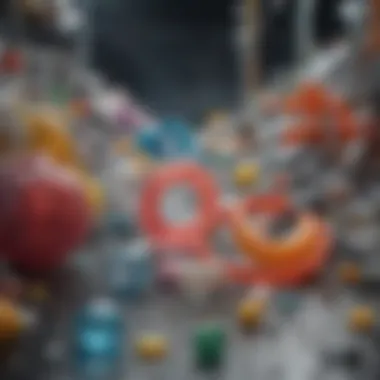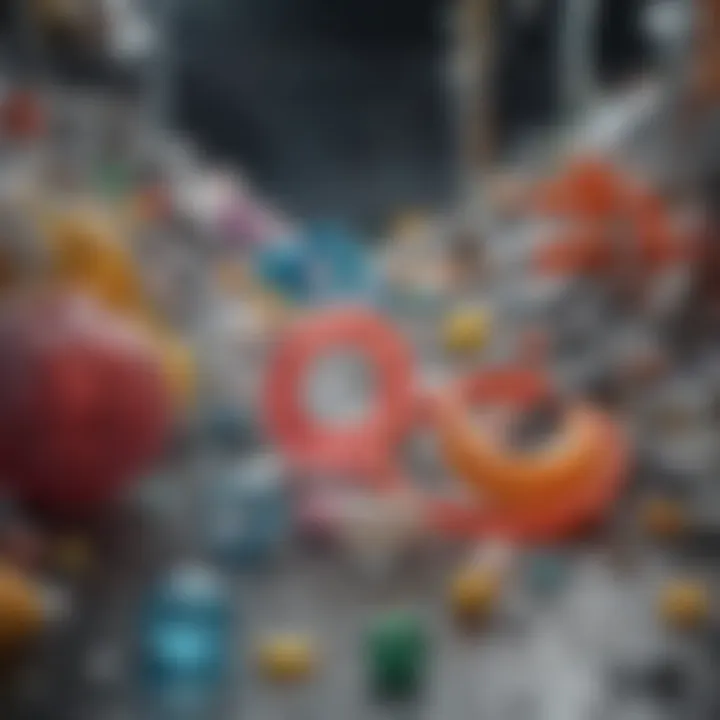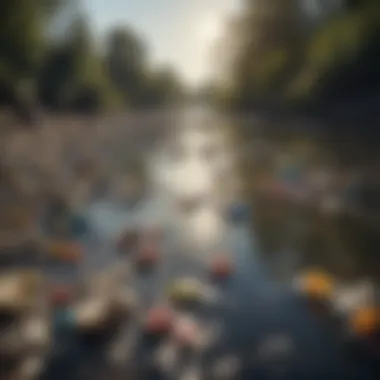Global Plastic Pollution: A Comprehensive Analysis


Intro
Plastic pollution is more than just an eyesore; it's a looming crisis with deep roots and widespread effects. Across the globe, rivers, oceans, and landscapes serve as unfortunate repositories for plastic waste. This examination takes a hard look at not just where this plastic comes from but also the toll it exacts on wildlife and human health. The prevalence of plastic in everyday life creates an urgent need for awareness and action.
In many ways, plastic has become synonymous with modern convenience. But when one sifts through the statistics—estimates suggest there are over 5 trillion pieces of plastic in our oceans alone—it becomes painfully clear that this convenience carries a hefty price. Recent studies have illuminated the intricate ways that plastic not only harms marine life but also infiltrates the food chain, posing potential threats to human health.
The quest to mitigate plastic pollution is multi-faceted, involving legislative frameworks, corporate responsibility, and grassroots movements. Each of these elements plays a pivotal role in battling a crisis that often feels insurmountable. This thorough review will not just discuss the extent of the problem but will also shine a light on innovative solutions that are currently being explored.
To effectively understand and combat this challenge, it is paramount to grasp the origins of plastic pollution and its implications. By delving into existing legislation, industry practices, and public attitudes, we can chart a path toward more sustainable living.
"A clean environment is not a luxury; it is a necessity for our survival and our future."
In this piece, we’ll peel back the layers of plastic pollution and emerge with insights that equip readers—students, researchers, and professionals alike—with knowledge to foster change and contribute to a cleaner planet.
Intro to Global Plastic Pollution
Understanding global plastic pollution is absolutely critical today. This issue isn't just about litter or unsightly beaches; it's a tangled web of ecological, health, and economic challenges that spans the planet. As plastic waste infiltrates every corner of our environment, from the deepest oceans to the remotest mountains, its effects not only compromise the natural world but also reverberate through our economies and societies.
Plastic has become ubiquitous in our daily lives. It’s in our packaging, our technology, and even our drinking water. The ease of use and versatility of plastic has led to its rampant production and consumption, creating a scenario where the sheer volume of waste challenges the capabilities of our disposal systems. Moreover, many of the wonderful things about plastic—its durability and resistance to decomposition—also turn into its biggest drawbacks.
"The world produces over 300 million tons of plastic each year, with nearly half intended for single-use products."
This section lays the groundwork for the reader to understand what plastic pollution entails, why it has evolved into such a major crisis, and the multi-faceted implications it carries. By diving into what plastic pollution means, along with its historical roots, we can better comprehend the path forward for solutions and mitigations.
Defining Plastic Pollution
Plastic pollution refers to the accumulation of plastic products in the environment, which adversely affects wildlife, wildlife habitat, and humans. The term incorporates various forms of plastic, including large objects like bags, bottles, and straws, as well as microplastics—tiny particles that result from the degradation of larger plastics.
- Types of plastic pollution include:
- Macroplastics: Visible items like grocery bags and water bottles.
- Microplastics: Smaller than 5mm, found in cosmetics, clothing, and industrial processes.
Plastic pollution is often categorized by its sources, including land-based, ocean-based, and airborne plastics. Understanding how each type impacts different environments is key to devising effective solutions.
History of Plastic Use
The timeline of plastic use showcases how an invention designed for durability over time morphed into a pressing global crisis. The first synthetic plastic, Bakelite, was developed in the early 20th century and heralded a new era of consumer products.
Over the following decades, plastics like polyethylene and PVC gained popularity in various industries, from construction to food packaging.
- 1950s: Post-war prosperity leads to increased consumer goods, many made of plastic.
- 1970s: The environmental movement begins to take shape, with early awareness of waste issues.
- 1990s: The proliferation of single-use plastics accelerates, coinciding with the rise of convenience culture.
As the years rolled on, plastic production skyrocketed. By 2015, the cumulative production of plastics reached approximately 8.3 billion metric tons, further complicating waste management efforts around the world.
In summary, through this examination of defining plastic pollution and its historical context, readers can appreciate the scale and permanence of this issue. This understanding lays the foundation for exploring the subsequent sections of the article, where we will delve deeper into the environmental implications, health concerns, economic repercussions, and potential solutions.
Trends in Plastic Production and Consumption
Understanding the trends in plastic production and consumption is essential for grasping the broader implications of plastic pollution. As the world becomes increasingly reliant on plastic, the strategies and methodologies surrounding its production and usage are constantly evolving. This section provides a critical lens on the shifts in industry practices and consumer behaviors that have significantly influenced the current state of plastic waste.
Industry Growth Over the Decades
The growth of the plastic industry has been astonishing over the last several decades. Back in the 1950s, plastic was still a material primarily used for specialized products. Today, the industry blossomed into a global powerhouse, producing over 300 million tons of plastic every year. One factor behind this industrial boom is the affordability of crude oil, a primary raw material for most plastics. When oil prices remained low, producing plastic became cheaper and more widespread, leading industries to substitute traditional materials with plastic alternatives.
However, it’s not merely about the quantity produced. Innovations in plastic technology have broadened its applications. From packaging to automotive parts, the versatility of plastics makes them an attractive option for manufacturers.
"As we dive deeper into the 21st century, it’s clear that the plastic industry is not just growing - it's evolving."
Additionally, the advent of synthetic polymers paved the way for new recycling challenges. Without proper recycling initiatives in place, a vast amount of this plastic ends up in landfills and oceans. Therefore, understanding how production trends correlate with pollution levels is crucial for any meaningful discussion about environmental sustainability.
Consumer Behavior Shift
On the consumer side, behavior has undergone significant changes, driven primarily by a rising awareness of environmental issues. In recent years, there has been a marked shift toward eco-friendliness. People are becoming increasingly informed about the implications of plastic waste, urging manufacturers to adopt more sustainable practices. The younger generations, such as Millennials and Gen Z, are particularly vocal about their preferences for environmentally conscious products.
For instance, the surge in demand for reusable bags, bottles, and containers demonstrates consumers' readiness to change their habits. Such trends indicate a growing resistance to single-use plastics. Many enterprises are now responding by redesigning their products and packaging intentionally to minimize plastic use, recognizing that consumer expectations are evolving.
It’s important to note the paradox here: while there is an evident shift toward sustainability, the per capita consumption of plastic still continues upward, showing a discrepancy between awareness and actual behavior. In addition, many consumers still engage in behaviors that undermine the efforts to combat plastic waste. This consumer behavior is often influenced by convenience and cost, which remain significant factors when individuals make purchasing decisions.
In summary, both the growth of the plastic industry and changes in consumer behavior play vital roles in shaping the current landscape of plastic pollution. Decoding these trends helps create a holistic understanding that can inform both legislative measures and individual responsibility in tackling this pressing issue.


Environmental Impact of Plastic Waste
The topic of environmental impact due to plastic waste is crucial in understanding the broader implications of pollution on our planet. Plastic waste doesn’t merely exist; it continually interacts with ecosystems, shaping not just the marine environment but also terrestrial habitats. As waste accumulates, it disrupts biological processes, and understanding these impacts is essential to devise effective solutions and preventive measures.
Effects on Marine Ecosystems
Microplastics and Marine Life
Microplastics are tiny plastic particles, often less than five millimeters in length, that have emerged as a significant concern for marine life. These particles can originate from larger plastic debris breaking down in the ocean, as well as from the fibers shed by synthetic textiles during washing. The presence of microplastics in the oceans affects marine organisms in a multitude of ways.
One alarming aspect is that many marine species, from fish to crustaceans, mistake microplastics for food. Once ingested, these particles can cause internal injuries, disrupt digestion, and even lead to the bioaccumulation of toxic substances. It's a hidden danger; as smaller animals consume microplastics, they become increasingly present in the food chain, ultimately impacting human health through seafood consumption.
The key characteristics of microplastics are their longevity and invisibility. They do not biodegrade like organic waste but rather linger in ecosystems for decades—or longer. This durability raises significant concerns about the long-term viability of marine species and the overall stability of ocean habitats, making the study of microplastics critical for understanding plastic pollution's impacts.
"The ocean is not a dumping ground. The future of marine biodiversity hinges on how we manage plastic waste today."
Impact on Fishing Industries
The fishing industry is directly affected by plastic pollution, both economically and ecologically. Plastic debris can damage fishing gear, resulting in significant financial losses for fishermen. Moreover, toxins from plastics can leach into marine organisms, compromising the safety and quality of seafood. This not only affects consumption but raises alarms for export markets.
When fishers pull in nets filled with plastic instead of fish, it diminishes their catch and threatens their livelihood. Furthermore, the perception of seafood safety is undermined when consumers become aware of plastics in marine environments.
The unique aspect of fishing industry impacts is the double whammy: not only do fishermen lose resources, but the entire ecosystem suffers further degradation if regulations and practices are not transformed to address these challenges. This insight opens a dialogue about new sustainable fishing techniques and regulations that must be considered to mitigate these effects.
Soil and Terrestrial Impact
Plastics don’t just affect the waterways; they also alter terrestrial ecosystems. When plastic waste accumulates in soil, it disrupts the natural composition and health of the ground. Microplastics can affect the soil microbiome—an essential component of soil health that influences plant growth.
The long-term effects are profound, potentially threatening food sources and biodiversity in agriculture as plastics seep into the ecosystem. Understanding these interactions is vital when pushing forward on meaningful legislative and consumer practices to reduce plastic usage. It's clear that addressing plastic pollution requires a holistic view that encompasses both marine and terrestrial pathways.
Health Implications of Plastic Pollution
The health implications tied to plastic pollution cannot be brushed under the carpet, as they weave a complex web that creeps into various aspects of our lives. It’s not merely the environmental concerns that we should keep in mind; the ramifications of plastic waste on human health are equally alarming. Plastics break down into smaller particles or leach toxic chemicals, both of which pose significant risks. Understanding these effects is crucial because it highlights the necessity for immediate action and drives home the notion that plastic waste impacts not just the environment, but also public health.
Toxic Chemicals and Human Exposure
Plastics are often treated with a variety of additives that enhance their properties but can compromise safety. Chemicals like phthalates and bisphenol A (BPA) are common culprits, popping up in everything from food packaging to personal care products. When plastics degrade or are incinerated, these hazardous substances can escape into the air, groundwater, and food chain.
Ingesting contaminated water or food exposes humans to these unsettling toxins. For instance, those who consume seafood might unknowingly ingest microplastics, which have absorbed harmful chemicals during their journey through the ocean. A study indicated that in certain regions, up to 83% of tap water contained microplastic particles. This alarming finding raises the question: how safe is our drinking water?
- Here’s a breakdown of common toxic chemicals found in plastics:
- Phthalates: Often used in flexible plastic materials, linked to hormonal disruptions.
- BPA: Known to interfere with endocrine function, leading to potential reproductive issues.
- Heavy Metals: Contaminants can enter plastics during the production process, posing risks to health.
"When strong chemicals leach into our essential resources, the entire food web—from the ocean to our plates—gets jeopardized."
Long-term Health Consequences
The long-term health consequences of exposure to plastic pollution are still being unearthed, but alarm bells are already ringing. Accumulated exposure to harmful chemicals can lead to chronic health problems. Researchers have linked some of these substances to serious conditions such as obesity, diabetes, reproductive issues, and even certain types of cancer.
A concerning aspect is the vulnerability of children. Studies reveal that exposure to plastics during critical developmental stages can have lifelong repercussions. For example, children exposed to phthalates might demonstrate behavioral issues, and growing data suggests links between environmental pollutants and rising cases of ADHD.
- Potential long-term effects on health include:
- Hormonal Imbalance: Disruptions in hormonal activities can lead to reproductive health issues.
- Immune System Impact: Ongoing exposure may weaken the immune defense mechanism over time.
- Cancer Risk: Persistent exposure to certain chemicals has been under scrutiny for increasing cancer susceptibility.
The implications are quite clear; plastic pollution doesn't just stain our beaches or clog our waterways. It seeps into our health systems, making it a multifaceted issue deserving immediate attention. Healthier choices and more sustainable management of plastics can pave the way toward a safer future, particularly for vulnerable populations.
Economic Consequences of Plastic Waste
Understanding the economic consequences of plastic waste is crucial in grasping the broader impact of plastic pollution. It's not just an environmental issue; it has significant implications for economies globally. The costs associated with managing plastic waste can strain public budgets, and the effects ripple through various sectors. Exploring specific elements, such as cleanup efforts and the tourism sector, illuminates how intertwined plastic pollution is with economic health.
Cost to Cleanup Efforts
Cleanup operations are a substantial economic burden. Municipalities allocate hefty resources to manage plastic waste, particularly in coastal regions where litter can accumulate after storms. For example, cities like San Diego and Miami invest millions annually in beach clean-up initiatives. If we think about it, these costs don't just vanish. They're reflected in taxpayer dollars that could fund essential services like education and infrastructure.
"Dealing with plastic waste is like trying to sweep the ocean; the sheer volume challenges municipal budgets and resources."
The direct costs include:


- Labor for cleanup crews.
- Equipment like boats, nets, and bins.
- Disposal of collected waste, which often ends in landfills or incinerators.
- Public awareness campaigns to reduce littering.
Moreover, these cleanup efforts often lead to indirect costs. For instance, if local governments funnel significant finances into waste management, there may be less available for social programs or economic development initiatives. Thus, the economic impact of plastic pollution extends far beyond the immediate cleanup expenses.
Impact on Tourism and Recreation
Aside from the cleanup costs, plastic pollution also takes a toll on the tourism industry, which thrives on natural beauty and recreation. Tourists often seek destinations known for their pristine beaches and unspoiled ecosystems. When those landscapes are marred by trash on shorelines, it can dissuade potential visitors.
Consider locations like Bali or the Maldives – beautiful island paradises that face the drawback of pollution. Travelers may change their destination plans if they hear about polluted beaches. This decline in tourism can lead to:
- Decreased revenue for local businesses: Restaurants, hotels, and shops might see less foot traffic.
- Unemployment: A reduction in tourism often leads to job losses in sectors dependent on traveler spending.
- Strain on community resources: Local governments might struggle to balance budgets without the tax revenue that tourism typically brings.
Tourism boards recognize the need to combat plastic pollution to maintain their appeal. As it stands, a clean destination can stand out in marketing efforts, while pollution can serve as a deterrent. The economic ramifications are clear; investing in solutions to mitigate plastic waste potentially restores a location's reputation and boosts visitation.
The intertwined nature of plastic pollution and economic consequences necessitates a comprehensive approach. By understanding the costs incurred and the losses faced by industries reliant on clean environments, the urgency to address plastic waste becomes all the more pressing.
Efforts on both personal and community levels can stem these economic losses, ultimately leading to a healthier environment and a more stable economy.
Legislative Responses to Plastic Pollution
The fight against plastic pollution requires more than just public sentiment or individual action; it demands a coordinated response from governments and international bodies. The legislative responses to plastic pollution are crucial as they provide a structured framework to regulate, manage, and mitigate the impacts of plastics on the environment. These laws and agreements shape behaviors, influence industry practices, and hold organizations accountable, making them a fundamental aspect of the broader conversation about sustainability.
Effective legislation not only targets the symptoms of plastic pollution but also addresses its root causes. By establishing guidelines that encourage responsible production and waste management, legislation can lead to a marked reduction in plastic use and a shift toward sustainable alternatives. The benefits of such interventions are tangible—reduced environmental degradation, improved public health outcomes, and economic savings in cleanup and health-related costs. Yet, successful implementation of these regulations hinges on their design and the political will to enforce them.
International Treaties and Agreements
At the global level, international treaties play a pivotal role in shaping national policies toward plastic waste. Significant agreements like the Paris Agreement highlight the collective commitment to environmental issues, but there are specific treaties tailored for plastic pollution. For example, the Basel Convention provides guidelines for the transboundary movement of hazardous waste, which includes certain types of plastic waste.
These international agreements facilitate cooperation among countries, making it easier to share strategies and resources in tackling plastic pollution. They also create accountability at the national level, pressuring governments to align their policies with global standards. The concept of a "global plastics treaty," which has been suggested by various organizations, would consolidate efforts to limit plastic production and enhance recycling initiatives across borders.
"International cooperation is not just beneficial, it is essential for a problem as pervasive as plastic pollution. Treaties help ensure that all nations commit to a shared approach."
To successfully navigate the complexities of plastic waste, countries must work together and be held accountable for their contributions to the crisis.
National Regulations and Policies
On the domestic front, national regulations serve as the backbone for implementing changes that can directly influence reduction strategies. Policies vary dramatically across countries, reflecting local contexts, economic scenarios, and environmental priorities. Nations such as Germany and Canada exemplify strong frameworks that incorporate bans on single-use plastics, incentives for recycling, and penalties for non-compliance.
One effective approach has been the introduction of Extended Producer Responsibility (EPR) schemes, which require manufacturers to assume responsibility for the lifecycle of their products. This means that companies must ensure their products are recyclable or biodegradable, thereby pushing innovation in sustainable packaging options.
The role of NGOs and public advocacy cannot be overstated. Grassroots movements often influence legislative outcomes by raising awareness and pressing policymakers for change. Public campaigns play a crucial role, mobilizing citizens and creating a groundswell of support for stronger laws and regulations.
In summary, the legislative framework around plastic pollution is constantly evolving. Both international treaties and national policies serve as crucial instruments in addressing this pressing global issue. The effectiveness of these legislative measures hinges on collaboration, innovation, and the political will to make substantive changes. Only through robust legal responses can we hope to turn the tide on plastic pollution and safeguard our planet for future generations.
Industry Interventions and Innovations
As the plastic pollution crisis spirals further out of control, there’s an urgent need for industries to pivot towards more sustainable practices. Industry interventions and innovations are not merely buzzwords; they signify a shift in how manufacturers, retailers, and consumers engage with plastic products. By prioritizing sustainable solutions, companies can alleviate some of the burdens on the environment while also benefiting their bottom lines. The potential for meaningful change starts with the understanding that every small action, whether it’s developing new materials or changing production methods, can ripple outwards into substantial environmental impact.
Sustainable Packaging Solutions
Packaging is often the first point of contact consumers have with a product, making it a critical area for innovation. Conventional plastic packaging is not only ubiquitous but also a significant contributor to waste. As companies reassess their packaging strategies, several sustainable solutions have emerged. Examples include:
- Plant-based materials: Companies like Unilever and Nestlé are investing in biodegradable packaging made from renewable resources, such as cornstarch or sugarcane. These materials break down more swiftly than traditional plastic when composted.
- Minimalist approach: Reducing the amount of packaging used altogether can lead to fewer materials being produced. Brands like Warby Parker have utilized "no-box" shipping, where glasses are shipped with little to no extra packaging.
- Recycling-friendly designs: Some companies are redesigning their packaging to be more easily recyclable. Coca-Cola’s initiative to simplify their bottle materials has improved recycling rates significantly.
The benefits of these sustainable packaging solutions go beyond just environmental rectitude. They can create consumer loyalty, as an increasing number of people prefer products that are packaged with eco-friendliness in mind. Also, regulatory pressures and consumer expectations often compel businesses to rethink their practices, providing a clear incentive for adopting innovative packaging solutions.
Biodegradable Alternatives
In conjunction with sustainable packaging, the rise of biodegradable materials marks a significant shift in how industries approach plastic use. Unlike traditional plastics that can linger in the environment for hundreds of years, biodegradable alternatives break down into natural substances, thereby offering a less damaging option for the planet. Key points to consider include:
- Types of Biodegradable Plastics: Not all biodegradable plastics behave alike. Polylactic acid (PLA), derived from fermented plant starch, is one widely used option that typically breaks down in industrial composting conditions. However, it may not decompose in typical landfill situations, leading to potential confusion around its actual efficacy.
- Consumer Education: Educating consumers about proper disposal methods is crucial. If biodegradable items are mixed within general waste without appropriate management, their benefits may be lost. Brands like BioBag educate consumers about correct disposal practices, allowing products to reach facilities where they can break down effectively.
- Market Growth: The field of biodegradable alternatives is ripe for innovations. With companies like BASF and NatureWorks pushing the boundaries, industries are beginning to realize that investing in solutions that address long-term sustainability can foster brand loyalty and attract a newer, more environmentally conscious demographic.
"Every action taken by industries impacts the lifespan of packaging, from creation to disposal. The onus is on businesses to innovate thoughtfully, taking into account future generations."
In summary, addressing plastic pollution through industry interventions and innovations creates a landscape where sustainability thrives. While challenges persist, the strides seen in sustainable packaging and biodegradable alternatives offer a glimmer of hope. A collaborative effort among industries, consumers, and policymakers could lead to broader changes that ultimately contribute to global health, ecological balance, and social responsibility.
The Role of Education and Awareness
In the quest to address the growing menace of plastic pollution, education and awareness serve as fundamental pillars. They play a vital role not only in enhancing understanding of the issue but also in galvanizing collective action. The significant potential of education is that it empowers individuals with the knowledge necessary to make informed choices. When people recognize the impacts of plastic on their environment, it can drive them to change personal habits and advocate for larger systemic changes.


Key Elements of Education and Awareness
Education on plastic pollution encompasses information about its origins, its lifecycle, and the multifaceted effects it has on the environment and human health. Schools, universities, and community programs can foster critical thinking about consumption patterns and waste management. Many water bodies for instance, are littered with plastics, and understanding the trajectory of such waste can impact local ecosystems, which many rely on for their livelihoods.
"Through targeted educational initiatives, communities can break the cycle of neglect surrounding plastic waste."
Benefits of Enhanced Awareness:
- Behavior Change: Informed individuals are more likely to adopt sustainable practices, such as reducing single-use plastic usage, promoting recycling, or participating in clean-up initiatives.
- Advocacy: With knowledge comes the impetus to advocate for better policies. An educated populace is empowered to engage with government and industry leaders to push for significant changes.
- Community Engagement: Education programs can foster a sense of community around plastic pollution, encouraging local actions that emphasize collective responsibility.
- Cultural Shift: By embedding messages about plastic pollution into the social fabric, education can help reshape norms and values to prioritize sustainability.
Public Campaigns and Initiatives
Public campaigns and initiatives have emerged as a powerful means of raising awareness about plastic pollution on a global scale. These campaigns vary in scope, from local clean-up drives to international observances like World Oceans Day. Notably, these campaigns often leverage mass media, social networks, and community engagement to reach a broader audience.
For example, initiatives like Plastic Free July encourage individuals and businesses worldwide to reduce their plastic consumption for the entire month. Such actions raise awareness and foster tangible commitments to change behavior long-term. Additionally, various NGOs and environmental organizations deploy interactive workshops and social media campaigns to highlight how everyday choices contribute to plastic pollution.
Effectiveness of Campaigns:
- Visibility: They capture public attention through creative strategies, such as eye-catching graphics and relatable narratives.
- Partnerships: Collaborations with well-known figures or brands can amplify messages, reaching audiences that may not engage with traditional education.
- Feedback Loops: Campaigns often measure the impact of their initiatives, allowing for adjustments based on responses or changes in public perception.
Inclusion in Educational Curricula
Integrating the topic of plastic pollution within educational curricula is an essential step for fostering long-term advocacy and change. When students learn about the environmental, economic, and health implications of plastic waste from an early age, it creates an informed generation ready to tackle this issue.
Curriculum integration can manifest in various forms, including:
- Science Lessons: Topics such as ecosystems and biodiversity can include discussions on how plastic pollutants disrupt habitats.
- Art Projects: Students can be encouraged to create art installations using recycled materials, bringing awareness to the artistic and environmental aspects of plastic waste.
- Field Studies: Real-world exposure through field trips to contaminated areas or recycling facilities allows students to engage with the topic practically.
- Social Studies: Discussions around policies and community actions regarding plastic waste can instill a civic sense of responsibility.
Ultimately, embedding plastic pollution education throughout school systems not only equips future leaders with critical knowledge but also instills a sense of agency. Young individuals, understanding the implications of their choices, are likely to champion sustainable practices throughout their lives.
Through these layered approaches—public campaigns and formal education—society can cultivate a robust understanding of plastic pollution, paving the way for significant change.
Case Studies of Effective Solutions
Addressing the challenge of plastic pollution requires more than just awareness or legislation; it needs concrete examples of effective solutions that can inspire and guide those looking to make a difference. Case studies of successful initiatives not only highlight what has worked but also showcase the adaptability of various strategies across different contexts. They serve as beacons for countries and communities grappling with similar issues. By examining these cases, we can identify crucial elements, benefits, and considerations that contribute to effective solutions in the fight against plastic pollution.
Countries Leading the Way
Several nations have risen to the challenge of combating plastic pollution, demonstrating innovative and effective measures. Norway stands out as a leader in recycling, boasting a remarkable recycling rate of around 97% for plastic bottles. This achievement stems largely from the country's deposit return scheme, which incentivizes consumers to return bottles for a refund. Besides Norway, Germany has also been a pivotal player in promoting a circular economy approach, focusing on reducing plastic waste and increasing recycling through strict regulations and public engagement.
In Bangladesh, a relatively under-resourced nation, innovative solutions have emerged to tackle the plastic crisis. The government has initiated a ban on single-use plastic bags, coupled with awareness campaigns that have encouraged citizens to switch to reusable alternatives. These measures have resulted in a notable reduction in plastic waste in urban areas.
Countries like Rwanda have adopted even more stringent policies, successfully implementing a total ban on plastic bags in 2008. This commitment to environmental stewardship has not only resulted in cleaner streets but has also fostered a cultural shift toward sustainability among citizens.
Innovative Community Projects
Local initiatives also play a significant role in addressing plastic pollution. One notable project is Plastic Bank in Haiti, which incentivizes community members to collect and recycle plastic waste. Participants earn points redeemable for goods and services, effectively turning plastic waste into a valuable resource. This approach not only clears trash from the environment but also provides economic opportunities for locals.
In Indonesia, a community-based program called Edukasi Sampah tackles plastic pollution through education and engagement. This initiative focuses on teaching children about the impacts of plastic waste, encouraging them to participate in clean-up activities and learn about recycling. By instilling a sense of responsibility in the younger generation, the program aims to foster long-term behavioral change within communities.
"The success of these projects lies in their ability to empower individuals and create a sense of community involvement, driving collective action toward combating plastic pollution."
Additionally, Surf Rider Foundation's initiatives, particularly in California, have mobilized local surfers and beachgoers to regularly engage in beach cleanups while advocating for policy changes at local and state levels. Such grassroots efforts not only help in reducing waste but also bring awareness to the issue at hand.
By closely examining these case studies, it becomes clear that successful strategies against plastic pollution often share a few common threads: community engagement, education, and incentivization. These principles not only provide frameworks for developing effective solutions but also highlight the importance of local action in the global fight against plastic pollution.
Future Perspectives on Plastic Pollution
In addressing the colossal issue of plastic pollution, what we choose to turn our focus to in the future holds immense significance. Not only is it about mitigating the current mess we're in, but it’s also about devising strategies to prevent this from happening again. Looking ahead provides a roadmap for advocacy, innovation, and cooperation. As urgent as the situation is, there are emerging solutions and shifts that could pave the way for more sustainable practices while considering economic and social factors. Here we examine two crucial elements: the necessity for global cooperation and the advancements in technology that can potentially redefine how we tackle plastic waste.
The Need for Global Cooperation
When talking about tackling plastic pollution, the phrase "no man is an island" could not be more fitting. The issue knows no borders; thus, a collective response is paramount. Here’s why global cooperation is essential:
- Shared Knowledge: Countries can learn from each other’s successes and failures. For instance, countries like Germany have made significant strides in recycling, while others are still figuring out the basics.
- Financial Support: Wealthier nations should not only implement local solutions but also support developing countries that may lack the resources to address their own plastic challenges. This could come in the form of technology transfer or financial aid.
- International Policies: Implementing global treaties or agreements such as binding outcomes similar to the Paris Agreement for climate change could align nations towards common goals. It sends a message that plastic pollution is a serious concern that must be collectively managed.
The ultimate goal here would be to create policies that are enforced uniformly, ensuring that large corporations and nations adhere to stricter regulations on plastic use and disposal.
Technological Advancements and Their Potential
As we look to the horizon, technology stands as a beacon of hope in the fight against plastic pollution. There are both current innovations and possibilities that show promise in reshaping our relationship with plastic:
- Biotechnology: Scientists are exploring the use of enzymes that can break down plastics into their original building blocks, allowing for easier recycling and reducing waste.
- Smart Waste Management Systems: Incorporating IoT (Internet of Things) in waste management can optimize collections and recycling processes. Smart bins could indicate fill levels and send alert signals, ensuring timely pickups and better resource allocation.
- Nanotechnology: This involves manipulating materials at an atomic level to develop more effective filtration systems that can catch microplastics before they enter waterways.
"Innovation is the key in our battle against plastic pollution. The future is even brighter with our continued investments in research and development!"
As we advance in our understanding of polymers and their behaviors in the environment, the potential for these technologies becomes clearer and clearer. Encouraging research funding and collaboration between industries, academia, and policymakers will be vital in transforming these innovations from concepts into practical applications.



